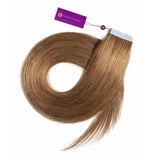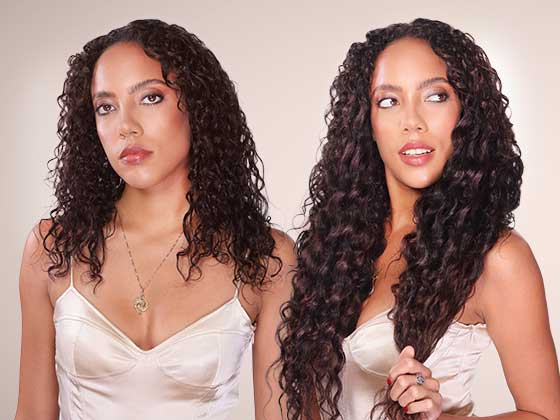New, improved and ready to ship! Over the last year based on your feedback, we've redesigned our popular Perfect Locks Hair Toppers from the base on up and also will be relaunching them with a wide array of sizes, textures and even colors.
- 3 textures: straight, wavy and curly
- Colors: virgin black, natural hair colors, as well as color effects: balayage and piano tone.
- Broader Silk ComfortBase™ and Mono Base offers totally seamless coverage
- Universal Flexible Part allows you part your hair any which way for a natural look and ultimate style expression
- Balanced hair density to offer you plenty of volume, but in a way that looks completely natural
- Made with 100% Ethically Sourced Human Hair, single source, direct from temples in India
- DuraLock Clips keep the unit firmly secure to your natural hair and leave it damage free
- Long lasting wear with 6 to 12 months with proper care and maintenance.
Shop New & Improved Toppers
A Message from Priyanka Swamy
Hair loss is a personal thing, it often comes so slowly that we don't notice we have less hair to work with until someone notices. This is particularly true for the area we, as women, tend to lose our hair over time: the top of the head.
Recent research has shown that up to 50% of women can expect to experience some level of hair loss during their lifetime. You may also not know that it's perfectly normal to drop between 50 to 100 single strands of hair per day during a process that is called "hair shedding". When the normal cycle of hair growth and fall becomes abnormal and you are losing more hair than is growing, you are experiencing the medical condition called "alopecia".

- Age: Can begin as early as 20s and 30s, but most common for women around age 45 - 55. 50% of women experience hair loss by age 50.
- Signs of female hair loss: Thinning of hair in the middle area of the scalp or a slow widening of the part.
- Common causes of female hair loss: Androgenetic alopecia, telogen effluvium, hormone changes after menopause, stress, nutrition.
- Emotional impact: More difficult for women as hair loss is tied to femininity and beauty. Women can feel less attractive with hair loss.
- How many women suffer?: 30 million women experience hair loss, making up 40% of hair loss sufferers in the United States.
One of the most important things when you notice hair loss is to not hide or run from it. Because it is important for you to determine the cause of it. Consult your doctor who will connect you with a medical professional who can diagnose the condition. Sometimes it's something as simple to being sick and your body fighting a major battle such as COVID or even recovering from a surgery. This form of hair loss is temporary, so in almost all cases your hair will return to normal in time. Sometimes however, it's a slow and gradual permanent loss of hair with thinning in other areas. No matter what the cause, as opposed to self diagnose, always talk to a doctor.
Below are some of the most common reasons for hair loss:
- Problems with hormone levels, such as abnormal levels of androgens (male hormones normally produced by both men and women)
- Genetic aging via inherited genes, from both male and female parents, may influence a person's predisposition to male or female pattern baldness.
- Stress, illness, and childbirth can cause temporary hair loss. Ringworm caused by a fungal infection can also cause hair loss. Learn what you can do to help reverse hair loss caused by stress.
- The side effects of drugs, including chemotherapy drugs used in cancer treatment, blood thinners, beta-adrenergic blockers used to control blood pressure, and birth control pills, can cause temporary hair loss.
- Burns, injuries, and X-rays can cause temporary hair loss. In such cases, normal hair growth usually returns once the injury heals unless a scar is produced. Then, hair will never regrow.
- Autoimmune disease may cause alopecia areata. In alopecia areata, the immune system revs up for unknown reasons and affects the hair follicles. In most people with alopecia areata, the hair grows back, although it may temporarily be very fine and possibly a lighter color before normal coloration and thickness return.
- Cosmetic procedures, such as shampooing too often, perms, bleaching, and dyeing hair can contribute to overall hair thinning by making hair weak and brittle. Tight braiding, using rollers or hot curlers, and running hair picks through tight curls can also damage and break hair. However, these procedures don't cause baldness. In most instances hair grows back normally if the source of the problem is removed. Still, severe damage to the hair or scalp sometimes causes permanent bald patches.
- Common to serious medical conditions can cause hair loss. Thyroid disease, lupus, diabetes, iron deficiency anemia, eating disorders, and anemia can cause hair loss. Most times, when the underlying condition is treated, the hair will return unless there is scarring as in some forms of lupus, lichen planus, or follicular disorders.
- A low-protein diet or severely calorie-restricted diet can also cause temporary hair loss. Get information about foods that can help prevent hair loss.
- Vitamin deficiencies. Deficiencies in vitamins A, B, C, D, and E, as well as iron and zinc, have been associated with hair loss.
We can help you with solutions to mask your thinning hair challenge and give you your dignity and confidence back, but it IS a medical condition, one that you should identify.
Tips On Styling Your Perfect Topper
Wash and Condition - Just like your natural hair, topper wigs need regular washing and conditioning. Use a sulfate-free shampoo and a nourishing conditioner to keep the wig clean and hydrated.
Heat Styling - Our toppers are heat-resistant, so you can use heat styling tools like straighteners or curling irons to achieve your desired look. Be sure to use a heat protectant spray to prevent damage.
Blending - Blend your topper with your natural hair by using a teasing comb to gently backcomb your hair at the root where the topper will sit. This creates a bit of lift and helps the topper blend in better.
Regular Maintenance: To keep your topper wig looking its best, brush or comb it gently to prevent tangles and matting. Store it properly on a wig stand or in a breathable bag when you're not wearing it.
Consult a Stylist - Consider consulting a professional hairstylist who has experience working with wigs. Book an appointment with us for personalized advice and assistance!















